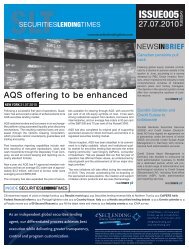Collateral Management - Securities Lending Times
Collateral Management - Securities Lending Times
Collateral Management - Securities Lending Times
You also want an ePaper? Increase the reach of your titles
YUMPU automatically turns print PDFs into web optimized ePapers that Google loves.
RegulationPlanningAutomating markets in a regulated worldTed Leveroni of Omgeo assesses the size of the undertaking that is facingthose that deal with collateral as new regulations take holdOne of the initial goals of regulations such as theUS Dodd-Frank Act and the European MarketsInfrastructure Regulations (EMIR) was to makemarkets simpler. In reality, however, they aremaking things increasingly more complicated. Infact, many believe that regulations are creatingthe need for more automation across the financialmarkets, because without more technology,the evolving regulatory mandates will be too difficultto manage. This is particularly true in the derivativesworld, with the move to central clearingof OTC derivatives and the increasing demandfor automated collateral management services.The notion under which Dodd-Frank and EMIRwere created seemed simple enough—give thesame clarity to OTC derivatives clearing that is givento futures. Initially, some thought that they couldsimply shift their existing futures clearing capabilitiesto OTC and satisfy their obligations, but that is notthe reality. To start, the centrally cleared capabilitiesthat we use for futures today have not become anestablished best practice. One might suggest thata best practice would be to take a page from theOTC model and have oversight, controls, checks,and collateral calls built into the process. It is not asimple undertaking, however, and there is a needto invest in technology to prepare for the change.According to research firm Celent, an estimated40 to 50 percent of OTC derivatives contractsare expected to be cleared by the end of 2013,leaving a $2.5 trillion collateral hole to fill. Firmswill need instant access to exposures—to knowwhere they stand at any moment, look at theircollateral holistically and facilitate clearing.There is no way that the market can manage itscollateral and risk management operations withoutproper technology to support it. Relying onthe current methods of manual processes andspreadsheets is not sustainable.There are a number of areas where automationcan benefit the new OTC derivatives environment.To start, regulations are set to impose more rigorousinitial margin requirements for all trades, whichwill surely increase the number of margin calls inthe mixed clearing environment. Every institution—big and small—will have to put up collateral foreach derivative transaction. As a result, even thelarger investment firms or more credit worthy managementhouses, which typically would never postan independent amount to their broker, will no longerhave that ability. New systems and processeswill need to be in place to manage the heightenedamount of calls across the market.The industry is also going to see a loss of exposurenetting from firms that currently clear throughmultiple central counterparties (CCPs) and clearingbrokers. In today’s bilateral world, these firmscan offset, or net, their exposure across multipletransactions with the same counterparty. Withtrading dispersed across multiple clearing venues,firms will not be able to ‘net out’, requiring firmsto not only have more collateral on hand to cover34the same amount of trades, but to also have theability to quickly assess what collateral they haveon hand to make the trade take place. There hasbeen talk of CCPs working together and allowingnetting of collateral across the industry, but again,there are many technical and business hurdlesthat would need to be met to make that a reality.There is going to be an overriding need for buysidefirms to be able to optimise their collateralusage at all times through improved, holistic managementof their margin and collateral calls, as wellas for consolidated reporting purposes. Improvedcollateral allocation processes will certainly makefirms smarter and more effective around collateraluse, and it is an area of operational investmentthat is urgently needed at firms across the globe.It is clear that the transition to a mixed clearing environmentis not going to be as straight-forward as onceimagined. In order to be effective, the operational processof moving OTC derivatives to a central clearingenvironment as demanded by regulators is going totake time and investment—from both a process andtechnology perspective. With deadlines looming, thebuy side needs to start assessing how they can best investin upgrading their current technology. Automationis a welcome change that, in the end, will allow firms tosatisfy regulators’ needs while bringing the increasedlevels of transparency and confidence that is urgentlyneeded. We just need to be sure that we take the propersteps in getting there before it is too late. SLTwww.securitieslendingtimes.com












